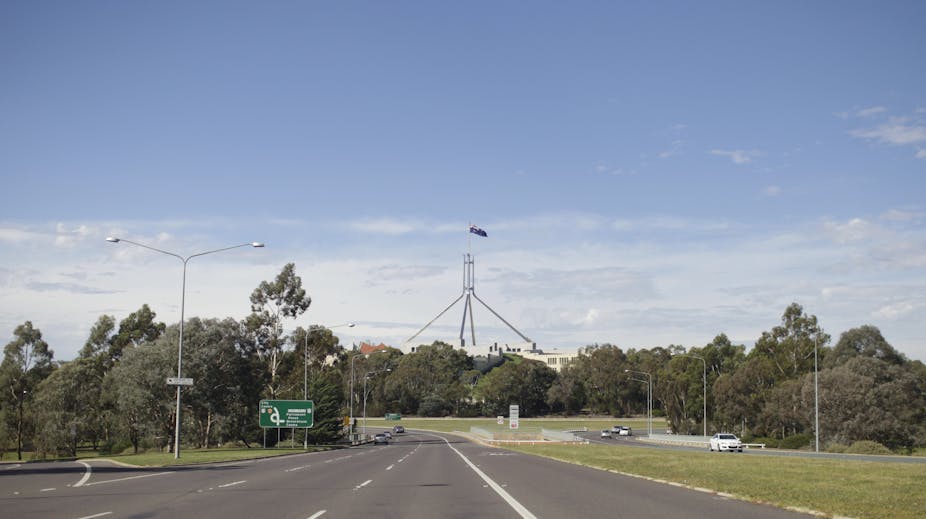“The Liberals have a secret plan to cut jobs in Canberra – 20,000 public service jobs are just the start of the Liberals’ plan to punish Canberra. Housing prices will plummet, unemployment will rise, and the small businesses that rely on them will suffer. Just like what happened when they were last in government.” Labor MP Andrew Leigh, letter to constituents in the federal seat of Fraser, Australian Capital Territory, July 2013.
The Coalition has repeatedly said it plans to reduce the size of the Commonwealth public service by at least 12,000 jobs, including in opposition leader Tony Abbott’s budget reply speech in May:
“We’ve announced that we’ll reduce by at least 12,000, through natural attrition, the size of the Commonwealth public sector that’s now 20,000 bureaucrats bigger than in 2007.”
The Coalition’s Real Solutions plan also discusses the need to reduce “the size of the bloated Commonwealth payroll, with a focus on natural attrition, to bring it closer to its size at the close of the Howard government” (page 17).
But the Coalition has never said it would cut 20,000 Commonwealth public service jobs.

Dr Leigh is the member for Fraser in the Australian Capital Territory, a safe Labor seat. When Election FactCheck contacted his office, we were pointed to interviews given by shadow treasurer Joe Hockey and opposition leader Tony Abbott where he stated that the size of the public sector was 20,000 larger than it was during the Howard government.
Dr Leigh seems to be conflating the two statements, without evidence that the Coalition has plans to cut jobs by 20,000.
How many jobs are likely to go in Canberra?
While the 20,000 figure misleads Dr Leigh’s constituents, the Coalition’s promise to cut at least 12,000 public service jobs would still be a substantial reduction of around 7% from a total workforce of around 168,000 (as at 30 June 2012).
They would also presumably come on top of recent cuts that have happened under Labor. Without even counting the latest announcement to further cut senior public service jobs to finance the bringing forward of an emissions trading scheme, the Labor government has applied large “efficiency dividends” without compensating agency budgets for the full costs of wage increases.
Dr Leigh has defended the new Labor cuts to senior public service jobs:
“That’s a level of the public service that has increased by 29% since 2007 while the rest of the public service has increased by 6%.”
Remembering that 40% of the Australian Public Service works in the ACT, if the coalition cuts were spread evenly around the country then job losses in Canberra would be more like 5000 – a quarter of the 20,000 figure Leigh uses in this letter.
But assuming Abbott sticks to previous commitments to protect front-office staff and try to locate as many public servants as possible outside Canberra, then the cuts could be disproportionately directed at Canberra, suggesting the best estimate may be closer to 10,000 or around half of Leigh’s figure.
However they are directed, the proposed cuts are substantial. In fact, given the reduction of around 3000 jobs since the peak in 2011, the Coalition cuts would mean the public service was actually smaller than the 155,400 jobs under the Howard government in 2007.
Impact on housing prices and the local economy
Adjusted for changes in the public service, the reduction between 1996 and 1999 under Howard was nearer to 30,000. Again the Canberra share of this reduction would have been much lower, but there certainly was a significant impact on the local ACT economy, including housing prices.
According to Andrew Leigh’s office in correspondence with Election FactCheck, between March 1995 and March 1998 the median house price in Australian capital cities grew by $22,950, and the median across all of Australia by $19,240. However, in Canberra the median house price fell by $5,750.
Dr Leigh also points to the ACT labour force growing by 1.3% in comparison to 3.4% growth Australia-wide, and both populations growing at similar rates (1.6% ACT and 3.7% Australia).
But the impact of the reduction planned by Abbott this time is unlikely to be so severe for a number of reasons, including because of the smaller size of the reduction, changed demographics and because of the increased size of the non-public service components of the ACT labour market.
However, job cuts on this scale could still exacerbate the national downturn that many economists are predicting over the next year or two.
Verdict
Based on the available evidence, Dr Leigh’s claim that the Coalition has “a secret plan” to cut 20,000 public service jobs is incorrect.
Review
Tony Abbott and Joe Hockey have both made it clear that there will be a cut of at least 12,000 public sector jobs “as a starting point”.
This stated position is often followed by the claim (disputed by many commentators) that the public service has 20,000 more employees than in 2007. Their frequent pairing of the two numbers is suggestive, but not proof of a secret plan.
Abbott’s statement late last year: “Do we really need 20,000 more public servants in Canberra today than we had at the end of the Howard era? We don’t” is even more suggestive, but still not proof.
At present Dr Leigh’s claim is a reasonable opinion, but not provable fact.
Hockey has indicated that the 12,000 public service job cuts would take place over two years. In the first two years under Howard the shrinkage was around 15,000.
So the minimum reductions proposed by Abbott are not much smaller than what occurred under Howard. And it is reasonable to think they will have similar effects on Canberra and the nation. – Christopher Stone.

